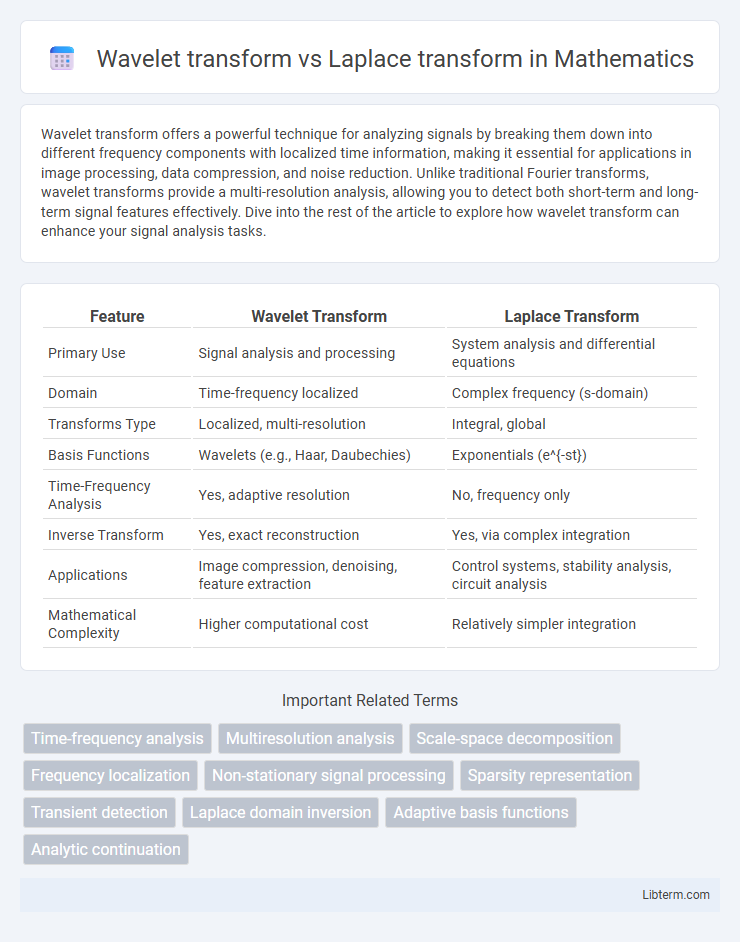Wavelet transform offers a powerful technique for analyzing signals by breaking them down into different frequency components with localized time information, making it essential for applications in image processing, data compression, and noise reduction. Unlike traditional Fourier transforms, wavelet transforms provide a multi-resolution analysis, allowing you to detect both short-term and long-term signal features effectively. Dive into the rest of the article to explore how wavelet transform can enhance your signal analysis tasks.
Table of Comparison
| Feature | Wavelet Transform | Laplace Transform |
|---|---|---|
| Primary Use | Signal analysis and processing | System analysis and differential equations |
| Domain | Time-frequency localized | Complex frequency (s-domain) |
| Transforms Type | Localized, multi-resolution | Integral, global |
| Basis Functions | Wavelets (e.g., Haar, Daubechies) | Exponentials (e^{-st}) |
| Time-Frequency Analysis | Yes, adaptive resolution | No, frequency only |
| Inverse Transform | Yes, exact reconstruction | Yes, via complex integration |
| Applications | Image compression, denoising, feature extraction | Control systems, stability analysis, circuit analysis |
| Mathematical Complexity | Higher computational cost | Relatively simpler integration |
Introduction to Signal Transformations
Wavelet transform decomposes signals into localized time-frequency components, enabling efficient analysis of non-stationary signals with variable resolutions. Laplace transform converts time-domain signals into complex frequency domain, primarily useful for solving differential equations and analyzing system stability. Wavelet transform excels in multi-resolution analysis, while Laplace transform is favored for linear time-invariant system characterization.
Understanding the Wavelet Transform
The Wavelet Transform excels at analyzing localized variations of non-stationary signals by decomposing data into time-frequency components with adjustable resolution, unlike the Laplace Transform which primarily handles global, exponential behavior of functions in the complex frequency domain. Wavelets provide multi-resolution analysis through scalable and translatable basis functions, enabling detailed feature extraction in signals with transient or time-varying characteristics. This adaptability makes the Wavelet Transform particularly effective for applications in signal processing, image compression, and biomedical engineering where time-localization of frequency content is crucial.
Basics of the Laplace Transform
The Laplace transform converts a time-domain function into a complex frequency-domain representation, primarily used for solving differential equations and analyzing linear time-invariant systems. It transforms a function f(t) into F(s) by integrating f(t)e^(-st) over t from 0 to infinity, where s is a complex variable. Unlike wavelet transforms, which provide time-frequency localization, the Laplace transform offers a global frequency analysis suited for system stability and control theory.
Mathematical Foundations: Wavelet vs Laplace
The Wavelet transform utilizes localized basis functions that vary in scale and position, enabling multi-resolution analysis ideal for time-frequency localization. In contrast, the Laplace transform operates with complex exponential kernels, converting time-domain functions into the complex frequency domain, emphasizing stability and system behavior analysis. Mathematically, wavelets rely on integral transforms with scalable wavelet functions, while Laplace transforms employ an integral over an exponential decay factor, highlighting their foundational difference in handling signal representations.
Time-Frequency Localization Capabilities
Wavelet transform offers superior time-frequency localization by providing multi-resolution analysis, enabling the detection of both short-duration high-frequency components and long-duration low-frequency trends with high precision. In contrast, Laplace transform primarily emphasizes frequency domain representation with limited temporal resolution, making it less effective for analyzing signals with time-varying frequency content. Wavelet transform's ability to adapt time and frequency windows dynamically results in enhanced performance in non-stationary signal processing compared to the fixed-window approach of Laplace transform.
Applications in Signal Processing
Wavelet transform excels in analyzing non-stationary signals by providing time-frequency localization, making it ideal for denoising, compression, and feature extraction in audio and image processing. Laplace transform is primarily used for solving linear differential equations and system stability analysis in control systems, with limited direct application to time-frequency analysis in signal processing. Wavelet transform's multi-resolution analysis surpasses Laplace transform when handling transient or time-varying signals.
Computational Complexity and Efficiency
Wavelet transform offers superior computational efficiency compared to Laplace transform by utilizing multi-resolution analysis and localized time-frequency representation, enabling faster processing for signals with abrupt changes. Laplace transform, being integral-based and focused on complex frequency domain analysis, generally requires more intensive computation and is less suitable for real-time applications. Wavelet transform algorithms, such as fast wavelet transform (FWT), exhibit lower computational complexity O(N) compared to Laplace transform methods, making them preferable for large-scale and high-speed signal processing tasks.
Strengths and Limitations Compared
Wavelet transform excels in analyzing localized variations of non-stationary signals with multi-resolution capabilities, making it ideal for time-frequency analysis and image compression, but it may suffer from computational complexity and less effectiveness in dealing with broad frequency components. Laplace transform provides powerful tools for solving linear differential equations and system analysis in the frequency domain, offering straightforward handling of initial conditions and stable system behavior, yet it lacks precise time localization and is less effective for non-stationary or transient signal analysis. Choosing between the two depends on the application requirements: wavelets for detailed, localized signal features and Laplace for global, system-level insights.
Choosing the Right Transform for Your Data
Wavelet transform excels in analyzing non-stationary signals due to its ability to provide both time and frequency localization, making it ideal for transient or time-varying data. Laplace transform is better suited for solving differential equations and analyzing system stability in linear time-invariant systems, as it converts functions from time to complex frequency domain. Choosing the right transform depends on the nature of your data: use wavelet transform for detailed time-frequency analysis and Laplace transform for control system modeling and transient response evaluation.
Conclusion: Key Takeaways and Recommendations
Wavelet transform excels in analyzing localized time-frequency signals, offering multi-resolution capabilities ideal for non-stationary data, while Laplace transform is powerful for solving differential equations and analyzing system behavior in the complex frequency domain. Wavelets provide superior performance in compression and noise reduction tasks, whereas Laplace transforms remain essential for stability analysis and linear time-invariant system modeling. For applications requiring detailed time-frequency localization, prioritize wavelet transform; for control systems and circuit analysis with emphasis on system stability, Laplace transform is recommended.
Wavelet transform Infographic

 libterm.com
libterm.com